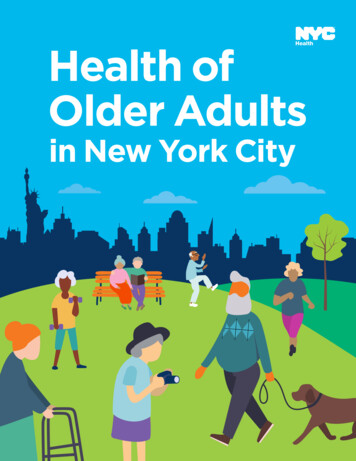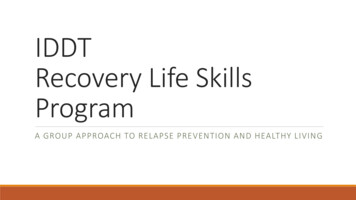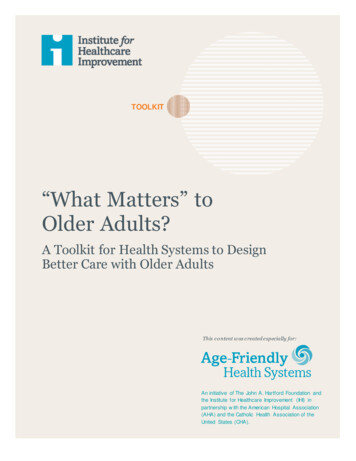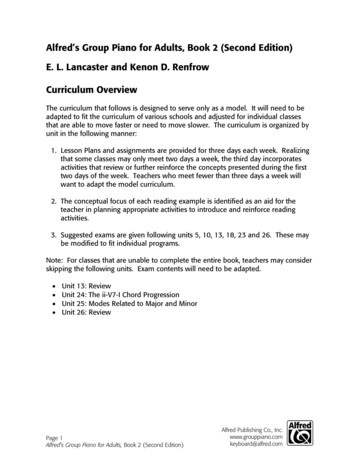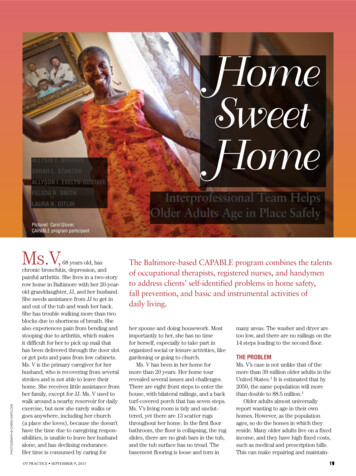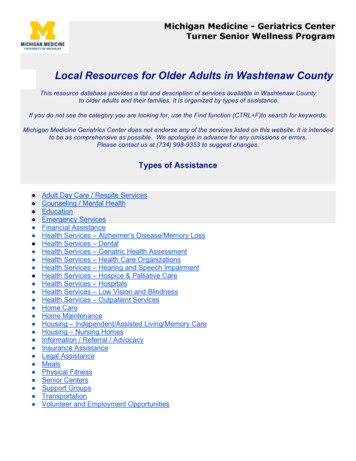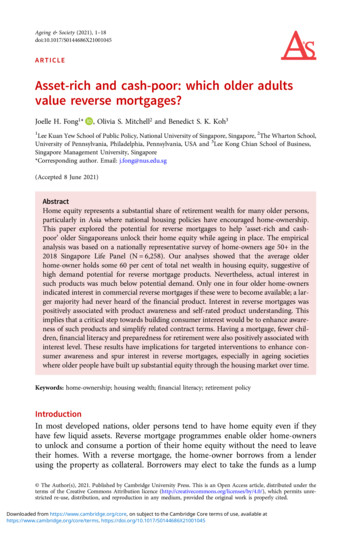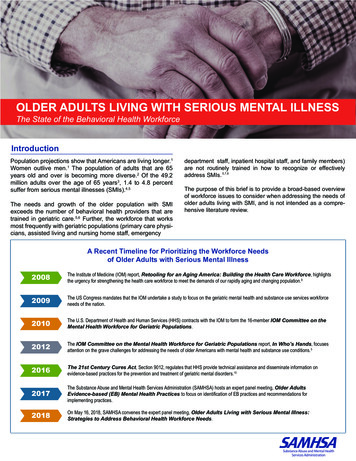
Transcription
OLDER ADULTS LIVING WITH SERIOUS MENTAL ILLNESSThe State of the Behavioral Health WorkforceIntroductionPopulation projections show that Americans are living longer.1Women outlive men.1 The population of adults that are 65years old and over is becoming more diverse.2 Of the 49.2million adults over the age of 65 years3, 1.4 to 4.8 percentsuffer from serious mental illnesses (SMIs).4,5The needs and growth of the older population with SMIexceeds the number of behavioral health providers that aretrained in geriatric care.5,6 Further, the workforce that worksmost frequently with geriatric populations (primary care physicians, assisted living and nursing home staff, emergencydepartment staff, inpatient hospital staff, and family members)are not routinely trained in how to recognize or effectivelyaddress SMIs. 5,7,8The purpose of this brief is to provide a broad-based overviewof workforce issues to consider when addressing the needs ofolder adults living with SMI, and is not intended as a comprehensive literature review.A Recent Timeline for Prioritizing the Workforce Needsof Older Adults with Serious Mental Illness20087KH ,QVWLWXWH RI 0HGLFLQH ,20 UHSRUW Retooling for an Aging America: Building the Health Care Workforce KLJKOLJKWV WKH XUJHQF\ IRU VWUHQJWKHQLQJ WKH KHDOWK FDUH ZRUNIRUFH WR PHHW WKH GHPDQGV RI RXU UDSLGO\ DJLQJ DQG FKDQJLQJ SRSXODWLRQ 20097KH 86 &RQJUHVV PDQGDWHV WKDW WKH ,20 XQGHUWDNH D VWXG\ WR IRFXV RQ WKH JHULDWULF PHQWDO KHDOWK DQG VXEVWDQFH XVH VHUYLFHV ZRUNIRUFH QHHGV RI WKH QDWLRQ 20107KH 8 6 'HSDUWPHQW RI HDOWK DQG XPDQ 6HUYLFHV 6 FRQWUDFWV ZLWK WKH ,20 WR IRUP WKH PHPEHU IOM Committee on theMental Health Workforce for Geriatric Populations 20127KH IOM Committee on the Mental Health Workforce for Geriatric Populations UHSRUW In Who’s Hands IRFXVHV DWWHQWLRQ RQ WKH JUDYH FKDOOHQJHV IRU DGGUHVVLQJ WKH QHHGV RI ROGHU PHULFDQV ZLWK PHQWDO KHDOWK DQG VXEVWDQFH XVH FRQGLWLRQV 2016The 21st Century Cures Act 6HFWLRQ UHJXODWHV WKDW 6 SURYLGH WHFKQLFDO DVVLVWDQFH DQG GLVVHPLQDWH LQIRUPDWLRQ RQ HYLGHQFH EDVHG SUDFWLFHV IRU WKH SUHYHQWLRQ DQG WUHDWPHQW RI JHULDWULF PHQWDO GLVRUGHUV 20177KH 6XEVWDQFH EXVH DQG 0HQWDO HDOWK 6HUYLFHV GPLQLVWUDWLRQ 6 0 6 KRVWV DQ H[SHUW SDQHO PHHWLQJ Older AdultsEvidence-based (EB) Mental Health Practices WR IRFXV RQ LGHQWLILFDWLRQ RI (% SUDFWLFHV DQG UHFRPPHQGDWLRQV IRU LPSOHPHQWLQJ SUDFWLFHV 20182Q 0D\ 6 0 6 FRQYHQHV WKH H[SHUW SDQHO PHHWLQJ Older Adults Living with Serious Mental Illness:Strategies to Address Behavioral Health Workforce Needs
The Changing Demographic of the Aging PopulationOver the past 10 years, the number of older adults who are over 65 years old increased by 33 percent.2 This population isprojected to almost double in 2060.3 The 2017 U.S. Census Bureau’s National Population Projections show that by 2030, allbaby boomers (people born 1946-1965) will be older than age 65. This will expand the size of the older population so that onein every five residents will be over 65 years old.11 At that point, the number of older adults will exceed the number of children.12Approximately 20 percent of adults that are 65 years old and over will experience mental health LVVXHV up to 4.8 percent willhave an SMI.5Based on the U.S. 2017 Census Report: Older Adult Population at a Glance2,13Between 2016-2040, the number ofindividuals 85 years old and over areprojected to increase by 129%.Persons reaching age 65 are expected tolive on average an additional 19.4 years(20.6 years for females and 18 years formales).Older women (27.5 million) outnumberolder men (21.8 million).About 28% (13.8 million) of persons overthe age of 65 live alone. Of those aged75 and over, nearly half of women (45%)live alone.Approximately 1.5 million older adults live in institutional settings, most commonly a nursing home. Thepercentage increases dramatically with age, ranging from 1% for persons ages 65-74 to 3% for personsages 75-84 and 9% for persons age 85 and over.Approximately 9.3% of the total population of individuals over 65 live below the poverty level. Another 4.9%of older adults were classified as "near-poor" (income between the poverty level and 125% of this level).Between 2016 and 2030, the white (not Hispanic) population age 65 and over is projected to increase by39% compared to 89% for older racial and ethnic minority populations, including Hispanics (112%),African-Americans (not Hispanic) (73%), American Indian and Native Alaskans (not Hispanic) (72%), andAsians (not Hispanic) (81%).Approximately 35% of older adults reports some type of disability (i.e., difficulty in hearing, vision, cognition,ambulation, self-care, or independent living).PAGE 2
DEFINITIONSThe definition of serious mental illnesses (SMIs) includes one or more diagnoses ofmental disorders combined with significant impairment in functioning. Schizophrenia,bipolar illness, and major depressive disorder are the diagnoses most commonly associated with SMI, but people with one or more other disorders may also fit the definition ofSMI if those disorders result in functional impairment.15Geriatric mental health workforce refers to the range of personnel providing services toolder adults with mental health conditions.5The terms “older adult” and “geriatric population” refer to individuals age 65 and older.5Co-occurring ConditionsAs a normal course of aging, older adults experience changesto their physical health, mental health, and cognitions. Interactions among these age-related factors can result in “spiral” or“cascade” of decline in physical, cognitive, and psychologicalhealth.18Statistics Relevant toOlder Adults with SMIA 2006 report of the National Association of State Mental HealthProgram Directors indicates that people with SMI die earlierthan the general population and are at higher risk for multipleadverse health outcomes.19 There may be a number of reasons.15%of older adults are impacted bybehavioral health problems16Older adults with an SMI have substantially higher rates ofdiabetes, lung disease, cardiovascular disease, and othercomorbidities that are associated with early mortality, disability,and poor function.20 They also have significant impairments inpsychosocial functioning.21 Older adults with SMI account fordisproportionately high costs and service use.20,21 Lifestyle andbehaviors (e.g., tobacco and alcohol use, sedentary) may putolder adults with SMI at greater risk for metabolic side effects ofantipsychotic medications and lead to obesity and chronic physical health conditions.20Among older adults, the rate of substance use disorders isreported as .2 to 1.9 percent.5,22,59 Approximately 1.4 percent ofolder women and 2.2 percent of older men reported past-yearuse of illicit drugs, including marijuana, cocaine, heroin, andprescription psychotherapeutic medications, such as painrelievers and antianxiety medications that are used for nonmedical purposes.5 The 2016 National Survey of Drug Use andHealth data indicate that there are approximately 863,000 olderadults with a substance use disorder involving illicit drugs oralcohol, but only 240,000 (approximately 27 percent) receivedtreatment for their substance use problem.59 Prevalencerates for older-adult at-risk drinking (defined as more than 3drinks per occasion; more than 7 drinks per week) are estimated to be 16.0 percent for men and 10.9 percent for women.22 Forindividuals who are 50 years old and up, misuse of opioids isprojected to be 2 percent.24In 2013, more than 7,000 people age 65 or older died bysuicide.25 Suicide rates are particularly high among older men,although suicide attempts are more common among older women.25 Suicide attempts are more likely to result in death amongolder adults than among younger people.254.8%of older adults are living with aserious mental illness5.2%.2 - .8%3 - 4.5%People aged 65 andolder account forof suicide deaths17bipolar disorder5schizophrenia5depression517.9%PAGE 3
Challenges Faced by a Provider WorkforceThere are a number of challenges to meeting the needs of olderadults with SMI. For example, there is little guidance on what coreknowledge is key for a workforce to address the needs of olderadults with SMI, or how much training is needed. 26,29 The diversityof the population in terms of ethnicity, culture, and language makeit a challenge to identify core capabilities of a workforce.28 Thus,there are significant gaps in the behavioral health care accessibleand provided to non-White populations. 31A big challenge for the workforce is the need to balance the principles of respecting the autonomy of the older adult with SMI andpromoting their welfare, since sometimes a client's decisionmaking capacity is in question. 30Interestingly, some have even argued that the workforce shouldlook at the needs of older adults as a dichotomy, with the youngold (age 60-74) and the older old (age 75 and up). 27,32 This isbecause many more individuals in the older old group live alone,are less mobile, and have increased numbers of physical healthproblems that need to be addressed. 5Older adults are at least 40 percent less likely than youngerindividuals to seek or receive treatment for mental healthcondi-tions.33 Those who seek services are unlikely to be seen bya provider who is trained in how to address the needs of a geriatric population.5,34There are a number of clinical situations when working with olderadults with SMI that may require additional knowledge and training of both the general and specialty workforce. Agitation can becommon among older adults when there are co-occurring dementias and medical conditions, even in the absence of SMI. 60 Agitation also can be prevented or reduced by utilizing behavioral cuesand supports such as orienting signs, proper lighting, and havingfamiliar caregivers. Training guides for direct care staff, whichprovide practical behavioral interventions for people with dementia, are available. 61 Personal contact with a known individual canbe helpful in preventing episodes of agitation. Such behavioralinterventions require a trained, consistent, and proficient workforce.A number of guidelines exist to help inform behavioral andtherapeutic interventions. Unfortunately, however, workforceshortages contribute to challenges with the implementation ofbehavioral interventions and other supports.When an individual’s behavior becomes concerning in a community or residential setting, consultation with geriatricpsychiatrists and other specialists can be helpful in directingcare. Such specialists can make recommendations to ruleout physical and neurologic conditions which may be contributing to the behaviors, such as stroke, infection, or otherphysical causes, and will make additional recommendationsabout behavioral and/or pharmacologic interventions. 62,63 Inaddition, specialists can be helping in ongoing management.For older adults with serious mental illnesses such as schizophrenia, ongoing treatment antipsychotics may be recommended. Consultation and/or ongoing treatment with aspecialist may be helpful in individuals with multiple medicaland psychiatric conditions.If the safety of the individual or others is at stake, medicationscan be used to manage behaviors, in addition to behavioralhealth interventions.64 A poorly trained or inadequate workforce – such as the unavailability of specialists, or low staffratios to help provide behavioral supports - may contribute tothe overreliance on medications, such as antipsychotics, tomanage agitation. In some circumstances, antipsychoticsmay be over-utilized in community and residential settings.65A black box warning was implemented in 2008 by the FederalDrug Administration for antipsychotic use among older adultsin nursing home settings due concerns about increasedmortality. 66 Subsequent actions by the Office of the InspectorGeneral and the Government Accountability Office highlighted the elevated use of antipsychotics in both community andnursing home settings. 67For older adults with serious mental illness, there is evenmore need for well-trained caregivers, primary providers, andspecialists. Having an adequate workforce will result in bettercare as well as decreased reliance on medications that mayhave the potential to cause adverse effects.UNIQUE FACTORS TO CONSIDER WHEN ADDRESSING1 JH UHODWHG FKDQJHV LQ WKH PHWDEROLVP RI SUHVFULSWLRQ GUXJV DOFRKRO DQG QRQSUHVFULSWLRQ GUXJV FDQ FDXVH RU H[DFHUEDWH PHQWDO SK\VLFDO RU VXEVWDQFH XVH FRQGLWLRQV 2/RVVHV WKDW RFFXU IUHTXHQWO\ LQ ROG DJH VXFK DV WKH GHDWK RI D VSRXVH SDUWQHU FORVH UHODWLYH RU IULHQG FDQ WULJJHU HPRWLRQDO UHVSRQVHV WKDW FDXVH RU H[DFHUEDWH PHQWDO KHDOWK V\PSWRPV 34 FXWH DQG FKURQLF SK\VLFDO KHDOWK FRQGLWLRQV DUH FRPPRQ LQ ROGHU DGXOWV DQG PHGLFDWLRQV WR WUHDW WKRVH FRQGLWLRQV FDQ FDXVH DQG H[DFHUEDWH PHQWDO GLVRUGHUV &RJQLWLYH IXQFWLRQDO DQG VHQVRU\ LPSDLUPHQWV WKDW RFFXU ZLWK DJH FDQ FRPSOLFDWH WKH GHWHFWLRQ DQG GLDJQRVLV RI PHQWDO GLVRUGHUV 7KH\ FDQ DOVR UHGXFH DQ ROGHU SHUVRQ¶V DELOLW\ WR IROORZ WKURXJK ZLWK UHFRPPHQGHG WUHDWPHQWV 52OGHU DGXOWV DUH OHVV OLNHO\ WR VHHN WUHDWPHQW IRU WKHLU PHQWDO KHDOWK FRQGLWLRQV FRPSDUHG WR \RXQJHU SHRSOH 2IWHQ WKH\ QHHG KHOS ZLWK WUDQVSRUWDWLRQ RU DUH OLYLQJ LQ D MRLQW KRXVLQJ VLWXDWLRQ LQ D IDPLO\ PHPEHUV KRPH QXUVLQJ KRPH RU DVVLVWHG OLYLQJ IDFLOLW\ 62OGHU DGXOWV DUH PRUH OLNHO\ WR VHHN UHOLJLRXV VXSSRUW RYHU WUHDWPHQW 2OGHU DGXOWV DUH PRUH UHOLJLRXV WKDQ WKH RYHUDOO SRSXODWLRQ DQG ILQGLQJ ZD\V WR WUDLQ DQG LQIRUP FOHUJ\ RU RWKHU UHOLJLRXV OHDGHUV PD\ KHOS LPSURYH DFFHVV WR VHUYLFHV 77KH JURZLQJ GLYHUVLW\ RI WKH ROGHU DGXOW SRSXODWLRQ UHTXLUHV WKDW SURYLGHUV EH FXOWXUDOO\ DQG OLQJXLVWLFDOO\ FRPSHWHQWLQ RUGHU IRU LQWHUYHQWLRQV WR EH HIIHFWLYH PAGE 4
Workforce Issues:Impact on Access to/Delivery of Services forOlder Adults with SMIQuestions about the relationship betweensupply and demand are common whendiscussing the health care workforce.However, when it comes to addressing theneeds of the older adult SMI population, itis not simple. There are no accurate datato show the number that makes up thegeriatric mental health workforce. 5 Themajority of psychiatric providers do nothave recognized credentials in geriatrics,although several curricula are emerging,such as a certification exam for nurseseducated in geriatric nursing (see Gerontology Nursing Certification Commission.Few mental health programs have mandated curricular standards related to SMIgeriatric patients. 7,26,30 Where there is acurriculum, it is unclear how and to whatextent the concepts are applied in theclassroom or in practical training. 5,26,30 Theincreasing racial, ethnic, and linguisticdiversity of the geriatric population alsomakes training in cultural competenceimperative, however, it is largely notaddressed. 26,30“The workforce preparedto care for geriatricMH/SU is inadequatein sheer numbers, withthe growth of thepopulation threateningto exacerbate this.”-Institute of Medicine, “The Mental Healthand Substance Use Workforce for OlderAdults: In Whose Hands?”Recent efforts to augment training show thateven when provided opportunities to specialize in geriatric mental health/ substance use(MH/SU), students often do not choose topursue it. 5,7 Experts suspect that the sheernumber of providers entering, working in,and remaining in the fields of primary care,geriatrics, mental health, substance use, andgeriatric MH/SU is disconcertingly small.5,9Further, with shifting models of care and thechanging roles of providers working onteams, it is not possible to estimate withgreat precision how many geriatric mentalhealth specialists will be necessary to servethe geriatric population. 5,7,9,26,30Barriers to Strengthening theGeriatric Mental Health WorkforceDefining the workforce –The geriatric mental health workforce is made up of many types ofproviders. The roles of providers within a geriatric treatment team areoften poorly defined and overlapping.5,7No accurate estimate of demand –Workforce data to make accurate predictions of workforce supply anddemand are not available.5,7,9,26,30General shortage of mental health providers –There is a general shortage of psychiatric providers across thecountry, especially those capable of prescribing medication andproviding evidence-based services.5,7 The workforce prepared to carefor older adults with SMI is inadequate.26,30Lack of training opportunities –Few opportunities for specialization in geriatric SMI exist.Professional training in geriatric psychiatry is inconsistent and not welldocumented because national standards and requirements in theseareas are minimal and vague.5,7-9,26,30,42 Most mental healthprofessionals have little training in geriatrics.5,8,9,26,30,42 Likewise, mostgeriatric specialists have little training in addressing SMI.5,7-9,26,30,42Lack of incentives for entering the geriatricprovider workforce –Few financial or professional incentives are in place toencourage geriatric providers to enter and stay in this field.5,8,42,43Provider geriatric competency standards createdin silos –Some professions have made progress on geriatriccompetency development though these efforts are often doneindependently and their dissemination and impact are not easilymeasured.7,8,26,29,34,42Lack of support for caregivers and communitysupporters –Often caregivers such as spouses, children, providers, and otherfamily are interested in participating in a care team, but do not get thesupport to do so.40,44 Likewise, community supporters, such ascommunity religious leaders, can help older adults connect withservices.41PAGE 5
Increasing the Number of Providers to Treat Older Adults with SMIThere are a number of complex and interacting factors that affect the growth and competence of a workforce that is preparedto address the needs of older adults with SMI.The caregivers and providers that have the most direct contact with older adult patients do not have training in identifying andaddressing mental health conditions. These include primary care providers, emergency department and hospital staff, advancepractice nurses, senior programming staff, assisted living staff, nursing home staff, and family members. Very few providers aretrained in how to address older adults and SMI.5,7,8,26,29,34,42Table 1: Progress in Preparing the Geriatric Workforce*DISCIPLINEGeriatriciansGeriatric PsychiatristsGerontology AdvancedPractice Registered Nurses(APRN, NP & CNS)Registered Nurses Certifiedin GerontologyGerontological SocialWorkersCertified GeriatricPharmacistsGeropsychologyGeriatric Physical TherapyGerontology-CertifiedOccupational TherapistsPROGRESSGeriatricians are doctors that specialize in older adults. As of 2016, the number of geriatricianswith up-to-date certifications had remained flat at 7,000 for the past 10 years. Approximately 300geriatricians are trained each year, and many fellowship positions are not filled.There were less than 2,000 certified geriatric psychiatrists, and many fellowship positions remainunfilled each year.In 2013, the certification in gerontology for NPs and CNS was phased out and combined withadult primary and acute care certifications. In turn, the number adult-gerontology certified APRNsignificantly increased to 12,000.From 2013 to 2014, the number of RNs certified in gerontology increased by 1.7%. In 2014,7,874 RNs were certified out of 3.1 million RNs nationwide.There is no certification in gerontology for social workers. In 2009, 1,318 individuals in a Mastersof Social Work program specialized in aging.Between 2010 and 2015, the number of pharmacists certified in geriatrics increased from 1,210to 2,158 (a 78% increase).In 2010, the American Psychological Association recognized professional geropsychology as aspecial area of psychology and started accrediting a geropsychology postdoctoral program. In2014, the American Board of Professional Psychology added geropsychology as a boardedspecialty.Between 2010 and 2015, the number of physical therapists certified in geriatrics increased from1,006 to 1,936 (a 92% increase). The number of residency programs expanded from six to 13.As of 2015, there were only 18 occupational therapists certified in gerontology.*T able adapted from Warshaw, G. & Bragg, E. (2016). The Essential Components of Quality Geriatric Care. Journal of the American Society on Aging, 40,(1).Ideas for Strengthening the Geriatric Workforce to Address SMIEmpower Older Adults. There is a growing emphasis onself-care. Educating older adults with SMI about their symptomsand encouraging self-care has been shown to be effective inincreasing quality of life and reducing unnecessary medicalcosts.44,45Empower Families. There is growing recognition of the important role that family members play as caregivers. These caregivers receive little support and training for caring for older adultswith SMI.5,46Strengthen the Role of Direct Care Workers (DCWs). Alongwith family members, these workers provide the vast majority ofservices to the elderly. However, this is a workforce that rarely istrained in recognizing and providing services to a person withSMI.5,41,47Integrate Peer Providers into the Workforce. Peer providersare sometimes referred to as peer support specialists, certifiedpeer specialists, and peer counselors, among other titles. TheU.S. Veterans Affairs Administration regularly employs peers towork as part of a healthcare team with older adults withPAGE 6SMI.5,47,48Develop continuing education for non-psychiatric health careprofessionals, including case managers, nurses, physician’sassistants, occupational therapists, and other health careprofessionals.34,42,48,49 Increase exposure of geriatric psychologyand psychiatry as a routine part of healthcare training.5Promote the development of curricula for inclusion in basicprofessional education for physicians, nurses, physical/occupational therapists, and pharmacists. Mentorship opportunities inthese professions should also be enhanced.34,42,48,49Train for Working on Integrated Care Teams. Providingservices as part of a provider team has shown positiveoutcomes for addressing the needs of older adults withSMI. 5,48,50 More training should be provided to all providerson how to effectively function on a clinical team.Utilize multi-disciplinary team planning as a means ofstrengthening and improving quality of care and promotingopportunities for training across disciplines.
DIRECT CARE WORKERSDirect care workers (DCWs), with minimal training, are employed to provide supportive services either in facilities or in homes. There isnot a single, unified occupational title for DCWs in aging, physical disabilities, or behavioral health. Occupational titles vary within eachsector and across sectors. In aging, there are generally three recognized job categories:#1Nursing assistants are employed in nursing homes and sometimes other residential settingssuch as assisted living.#2Home health aides are employed by Medicare- and/or Medicaid-certified home health agencies.#3Home care aides/personal care attendants are employed by agencies or hired directly byconsumers and/or their families and are employed in a range of community-based settings,including individual homes and apartments, adult daycare centers, and residential settings.5In addition, peer support specialists are increasingly being utilized to preform many of the behavioral health functions that are commonfor DCWs who provide services to elderly SMI populations.48There is a high turnover of DCWs due to poor working conditions, low wages, lack of training, and limited opportunities for advancement. While DCWs have the most contact with older adult patients, they do not have adequate training in geriatrics or MH/SU, andvirtually never receive training in both.5Programs and Services that Address the Needs of Older Adults with SMIThere are many models and services that have been shown to have a strong evidence base for addressing the needs of adults withSMI. Unfortunately, few of these have been thoroughly tested in older adult populations.5 Additionally, few account for the highnumber of co-occurring conditions, and the normal cognitive and physiological changes that accompany aging.5Effective practices and models for older adults with SMI need to consider how services are delivered (e.g., mobile units, transportation support, integrated health care settings); promote self-care and family involvement; and utilize an integrated care approach thataddresses the physical health, mental health, and substance use needs of the older adult.A few of the evidence-based programs that address the unique needs of older adults with SMI are listed in the Table 2. While mostfocus broadly on older adults with SMI, some focus only on depression, which is the most common mental health condition amongolder adults.Table 2: Some Evidence-Based Practices for Older Adults with SMINAME OF PROGRAMSMIxHealthy IDEASHelping Older PeopleExperience Success(HOPES)xxIMPACT CarePsychogeriatricAssessment andTreatment in CityHousing (PATCH)LIMITED TODEPRESSIONxDESCRIPTIONIntegrates depression awareness and management into existing case 5 management services provided to older adults. Integrates psychiatric rehabilitation and health management to improvepsychosocial functioning and to reduce the medical needs of olderpersons with SMI. 52Collaborative care model that is effective for reducing depression for olderadults in primary care settings. It includes shared accountability for patientoutcomes and processes of care amongst all providers andstakeholders. 53Drawing from Assertive Community Treatment (ACT) Model and theGatekeeper Model, this program trains local workers to identify at-riskindividuals, refer them for psychiatric follow-up and links them with amultidisciplinary provider team. 5,54PAGE 7
Advancing Evidence-Based Practices and Models for Older Adults with SMIThe complexity of what the older adult client experiences is not well captured in evidence-based practice models that are used withother age groups. While some evidence-based practices exist for older adults with SMI, there are few providers that are trained inhow to implement them.26,30,39 Many of the effective practice models rely on interdisciplinary teams of providers that work togetherto meet the diverse needs of older adults with SMI.51-54 Unfortunately, working on an interdisciplinary team is not a standard that istaught in many health care training programs.26,30,39 Self-help and peer support services are integrated in some of the most successful models of care, but funding these services is a challenge.45,55,56 These and other barriers need to be considered and addressedto help move the field forward.Recommendations that have emerged from recent Federal meetings:Use Emerging Technology to Expand ReachSince many older adults regularly use smart phones and other electronics to communicate, thistechnology maybe used to provide evidence-based treatment to those who would otherwise beunable to travel (homebound) or live in rural areas with few behavioral health options.5,57Encourage Integrated Care ModelsEncourage multidisciplinary teams of providers to work together to address the mental health,substance PLVuse, and physical healthcare needs. Regulations, funding, and incentives should beconsidered to support integrated care.26,30,39,58Consider Long-Term Sustainability of ProgramsToo often, programs that are effective for addressing the needs of older adults with SMI are fundedthrough a pilot study or a temporary funding stream, such as a grant. It’s difficult to sustain theseprograms once the initial funding expires.5 Serious thought should be given to funding throughstable reimbursement mechanisms. Consider making all components of effective models billable,especially within Medicaid and Medicare.58Offer a One-Stop-Shop for All ServicesOlder adults are less likely to seek services at a specialty care setting. Further, due to limitedmobility and lack of transportation, many older adults are reluctant to visit different locations toobtain their care. Thought should be given to how to provide services in one location or to bringingservices to the older adults.5,26,30,39 PAGE 8Report the Return on InvestmentFrom the Federal, State and policy maker perspective, it is important to articulate the return oninvestment. Evaluation data, including cost data and client outcomes, can help bolster funding,community and provider buy-in, and ensure sustainability.58
Select Federal ResourcesOlder Adult Behavioral Health Profiles by /behavioral-healthThe Federal Administration for Healthy Livinghttps://www.acl.gov/The Get Connected on-alcoholand-mental-healthEndnotes1.Vespa, J., Armstrong, D.M., & Medina, L. (2018). Demographic turning points for the United States: population projections for2020 to 2060. Current Population Reports, Report Number P25-1144, U.S. Census Bureau.2.Administration on Aging, Administration for Community Living. (2018). 2017 profile of older Americans. Washington, DC: U.S.Department of Health and Human Services.3.U.S. Census Bureau. (2017). The nation's older population is still growing: the nation’s population is becoming more diverse.Release Number: CB17-100.4.Hudson C.G. (2012). Declines in mental illness over the adult years: an enduring finding or methodological artifact? AgingMental Health, 16(6),735-52.5.IOM (Institute of Medicine). (2012). The mental health and substance use workforce for older adults: in whose hands?Washington, DC: The National Academies Press.6.American Psychological Association. (2014). Guidelines for psychological practice with older adults. American Psychologist,69(1), 34-65.7.Lehmann S.W., Brooks W.B., Popeo D., Wilkins K.M., & Blazek M.C. (2017). Development of geriatric mental health learn
old (age 60-74) and the older old (age 75 and up)., This is because many more individuals in the older old group live alone, are less mobile, and have increased numbers of physical health problems that need to be addressed. 5 27 32. Older adults are at least 40 percent less likely than younger individuals to
